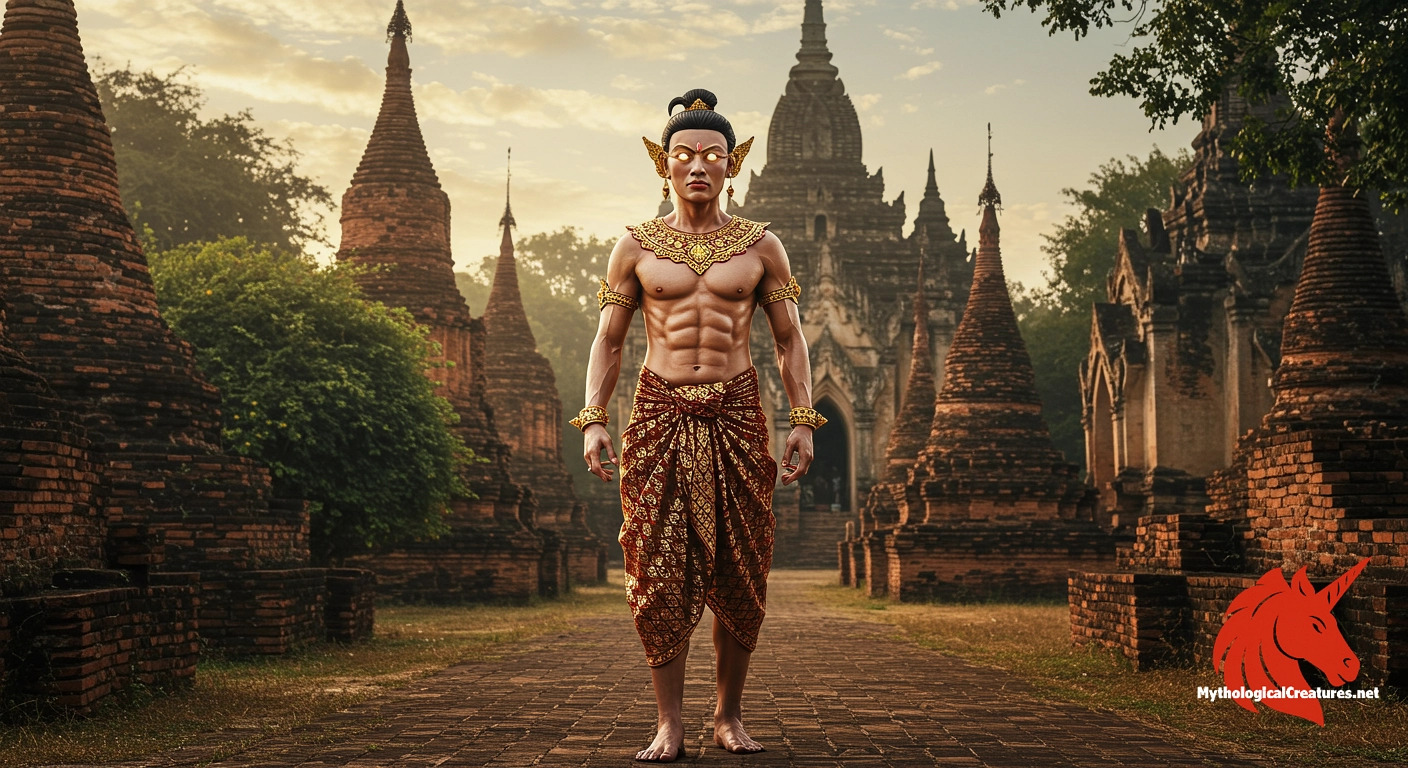Shwe Hpyin Naungdaw: Shwe Hpyin Naungdaw, also known as Shwe Hpyin Gyi or Min Gyi, is one of the 37 official Burmese nats and a venerated guardian spirit.

Shwe Hpyin Naungdaw
Shwe Hpyin Naungdaw - Central figure in the largest nat festival in Myanmar and an influential spirit in Burmese folk religion
Origins & First Encounters
Shwe Hpyin Naungdaw, also known as Shwe Hpyin Gyi or Min Gyi, is one of the 37 esteemed Burmese nats whose legend is interwoven with both historical events and mystic tradition. His emergence as a divine spirit is rooted in ancient narratives where mortal failings gave rise to supernatural guardianship, symbolising a bridge between the earthly and the spiritual realms. Born into a lineage linked to the sacred site of Taungbyone, his early life is marked by events that conferred both responsibility and consequence. His story, resonating with themes of duty and martyrdom, began when a neglected offering disrupted the harmony of a royal pagoda during King Anawrahta’s reign.
Over the centuries, his figure has been celebrated and venerated as a powerful protector and mediator in the complex tapestry of Burmese belief. His myth reflects the synthesis of Buddhist influences with indigenous animistic practices, forming an integral part of Myanmar’s cultural heritage. As a deified spirit whose existence underscores moral imperatives and the weight of ancestral expectations, he continues to inspire ritualistic reverence and artistic expression. The enduring appeal of his narrative lies in its ability to articulate the human condition, bridging historical memory with timeless spiritual lessons.
Source Texts & Tale Variants
The lore of Shwe Hpyin Naungdaw is sustained through a rich variety of sources, including ancient palace chronicles, local manuscripts, and vibrant oral traditions passed down through generations. Accounts of his life and transformation are embedded in the cultural practices associated with the Taungbyone Pagoda, where early records recount the disruption of sacred duty that led to his apotheosis. Diverse story variants highlight not only his personal tragedy but also the communal consequences of neglecting ritual responsibilities. Traditional performances and recitations during the Taungbyone Festival serve as dynamic testimonials to his enduring legacy.
Some regional narratives accentuate his martial prowess and dignified bearing, while others portray him as a benevolent intercessor whose intervention restored cosmic order. The folk renditions include symbolic elements that stress the importance of ritual offerings and the sanctity of sacred spaces. Modern interpretations have incorporated elements from various primary texts, ensuring that his myth evolves while retaining its essential moral core. This multifaceted transmission of his story demonstrates how historical records and lively folklore collectively solidify his status within the official pantheon of nats.
Form & Powers
Traditional representations of Shwe Hpyin Naungdaw vividly combine martial elegance with divine ornamentation, reflecting his elevated status among the nats. He is frequently depicted in resplendent gold, a hue that signifies both his otherworldly origin and his function as a spiritual guardian. In artistic portrayals, he stands upright with an assured posture, often shown with a sword elegantly shouldered—a symbol of his martial authority and readiness to act. His attire typically consists of layered robes adorned with intricate Burmese patterns, enhancing the visual impression of regality and sanctity.
His visage is rendered with a calm intensity, capturing a fusion of mortal grace and supernatural power, while his eyes are imbued with a subtle gleam that hints at ancient wisdom. Elaborate hairstyles and detailing in his ornamentation add to the richness of his iconography, reinforcing the themes of nobility and duty. The blend of robust physicality and ceremonial embellishments in his depiction serves to remind devotees of his role as both a protector and an arbiter of moral justice. Overall, his physical portrayal is as much an artistic statement as it is a spiritual symbol, encapsulating the intersection of beauty, strength, and divine authority.
Regional Faces
Across Myanmar, the worship of Shwe Hpyin Naungdaw displays a fascinating array of regional interpretations and adaptations. In central regions, particularly near Mandalay where the Taungbyone Festival is celebrated with great fervour, his image is interwoven with local ritual practices that blend theatre, music, and dance. Rural communities frequently introduce local motifs into his representation, imbuing the deity with characteristics that resonate with indigenous spiritual sensibilities and agricultural cycles. Variations in ceremonial texts and visual depictions reflect the diverse cultural landscapes, highlighting differing emphases on his protective and punitive aspects.
In some areas, the narrative surrounding his origins is enriched by local legends that incorporate influences from neighbouring traditions, including traces of Islamic and South Asian elements linked to his paternal heritage. These adaptations not only personalise his myth for distinct communities but also reinforce the idea of him as a unifying symbol across a varied cultural spectrum. Local rituals sometimes portray him as a compassionate benefactor who safeguards the community, while in other regions his martial attributes are accentuated as a reminder of the consequences of failing in one’s duty. Such regional variations underscore the dynamic evolution of his myth, ensuring that his legacy remains relevant and vibrantly alive in local cultural practices.
Cultural Parallels
When compared with similar entities in Southeast Asian and broader Asian mythologies, Shwe Hpyin Naungdaw epitomises the archetype of a mortal forced into divinity through unjust fate and subsequent redemption. His transformation from a flawed mortal to a revered guardian mirrors narratives found in neighboring traditions where historical figures become deified after a tragic lapse in duty. Comparable to certain spirit guardians in Thai and Cambodian folklore, his legend highlights the delicate balance between human error and the quest for cosmic justice. This cross-cultural phenomenon underscores a shared belief in the power of retribution and the possibility of spiritual transcendence ensuing from mortal failings.
Moreover, his story resonates with themes observed in various indigenous narratives of deified ancestors, where unfulfilled obligations and moral transgressions evolve into lessons of duty and redemption. Such parallels reveal how different cultures conceptualise the integration of historical events with myth, crafting entities that serve both as cautionary exemplars and as protectors. The synthesis of martial and mystical attributes in his portrayal aligns him with guardian deities whose roles extend to both enforcement and benevolence. In this way, Shwe Hpyin Naungdaw stands as a testament to the universality of myth-making, where personal tragedy transforms into communal strength through the ritualisation of memory.
Legacy & Modern Evolution
Throughout history, the interpretation and representation of Shwe Hpyin Naungdaw have evolved in response to both shifting political landscapes and changing cultural sensibilities. Initially documented within royal chronicles and traditional performances, his image has progressively merged with the broader spiritual and artistic practices evident in contemporary Myanmar. His narrative, once confined to historical texts, now thrives in the dynamic atmosphere of festivals, public art, and modern reinterpretations that celebrate the syncretism of Burmese belief systems. The annual Taungbyone Festival, in particular, has emerged as a crucial event in preserving and reinvigorating the ancient traditions associated with his legacy.
Modern renditions of his myth often explore themes of both personal responsibility and communal harmony, reinforcing his position as a symbol of moral and spiritual rectitude. Contemporary artists and performers draw on historical iconography while infusing new creative elements to reflect current societal values. In doing so, his legacy retains its relevance, continually offering insights into the interplay between the past and the present. As a living tradition, the myth of Shwe Hpyin Naungdaw serves not only as a reminder of bygone eras but also as an evolving narrative that adapts to the cultural rhythms of modern life.
Interesting Fact
Worshippers of Shwe Hpyin Naungdaw uniquely avoid pork, reflecting the belief in his father Byatta's Indian Muslim heritage and the integration of diverse cultural influences in his veneration.
Quick Creature Info
Origin:
Features:
Associations:
Our Mythic Legendary Rating:

Also Sometimes Known As:
Habitat:
Supernatural Powers:
Physical Attributes:
Abilities:
Behavior:
Lore:
Related Creatures, Tales or Lore
References
Discover Another Mythical Legend You May Not Have Heard Of?
Uncover the mysteries of ancient folklore and expand your knowledge of legendary beings from cultures around the world.
Dare to Meet the Grani....
Curated by the Mythological Creatures Team (rev. May 2025)
